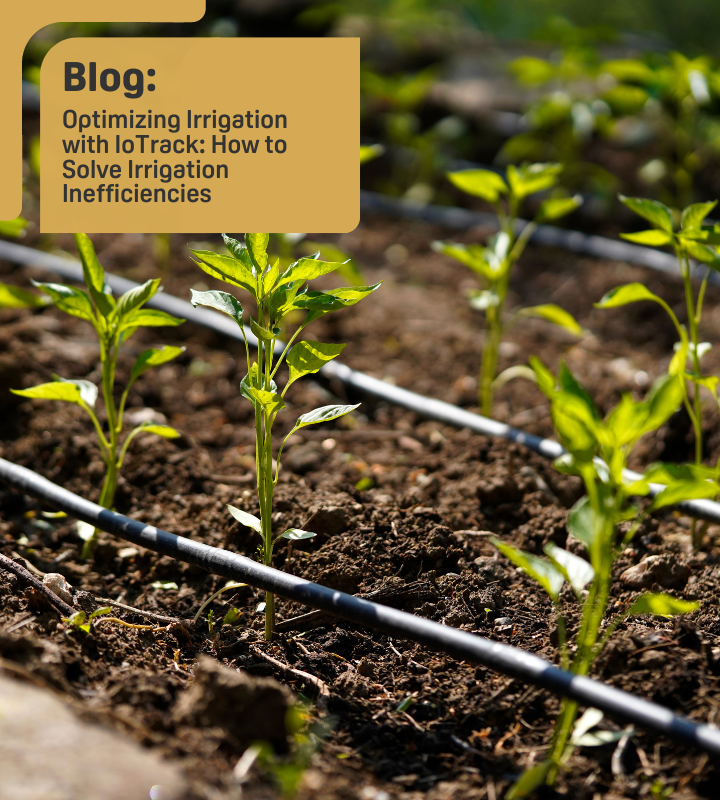

Optimizing Irrigation with IoTrack: How to Solve Irrigation Inefficiencies
Unlock the potential of precision agriculture to save water, improve yields, and cut costs through real-time soil moisture monitoring with Filiz and IoTrack.
Published on 26 March 2024
Introduction to Irrigation Efficiency
Water is a farmer's most precious resource, yet water management in agriculture faces significant challenges due to traditional irrigation practices' inefficiencies. With the advent of precision agriculture, solutions like Filiz Agricultural Sensor Station and IoTrack mobile applications are revolutionizing how farmers and agronomists monitor soil moisture levels and optimize irrigation. The journey toward optimized irrigation involves understanding and addressing common issues such as excessive or too frequent irrigation and stressed crops due to insufficient irrigation practices. Each of these scenarios can negatively impact crop health and yield, not to mention lead to unnecessary water and water waste.
IoTrack offers a targeted approach to tackle these challenges. Providing real-time data on soil moisture levels enables farmers to make informed decisions about when and how much to irrigate. This precision avoids the pitfalls of over or under-irrigating and supports sustainable agriculture practices. Implementing IoTrack in farming operations is straightforward and starts with installing the Filiz Agricultural Sensor Station in the field. Filiz feeds data to the IoTrack app, which analyzes the information and provides actionable insights. By following these insights, farmers can adjust their irrigation practices to ensure optimal soil moisture levels, leading to healthier crops and improved yields.
Field Capacity
Field capacity is a crucial agricultural concept, defining the optimal moisture level in the soil for plant growth. By monitoring soil moisture levels, farmers can ensure they're not over or under-irrigating, conserving water, and their crops receive exactly what they need to thrive.
Field capacity—the soil's moisture saturation point—depends on your soil type and is critical in defining efficient irrigation practices. Exceeding this threshold means that your soil cannot retain the excess water, which drains away, taking the potential for optimal root zone moisture with it. The soil becomes saturated when water in the soil exceeds a certain threshold. Your irrigations may not be as effective as before because the excess water will flow deeper into the soil under gravity rather than being held at the effective root depths. This can result in reduced water availability for the plants. However, soil moisture levels can be less than field capacity, which may lead to water stress. The water stress point depends on your soil type and product type. It can be defined as the minimum soil moisture level required for the healthy phenological development of plants to continue. Soil moisture levels below this level cause plant water stress, the most important obstacle to plant development. In addition, there is a significant decrease in crop productivity in water-stressed crops.
This is where IoTrack comes in, offering a tailored solution to manage minimum and maximum soil moisture thresholds and optimize irrigation based on real-time data. Let’s dive into how IoTrack visualizes irrigation data by looking at the ideal and problem cases.
How Does Ideal Irrigation Look Like?
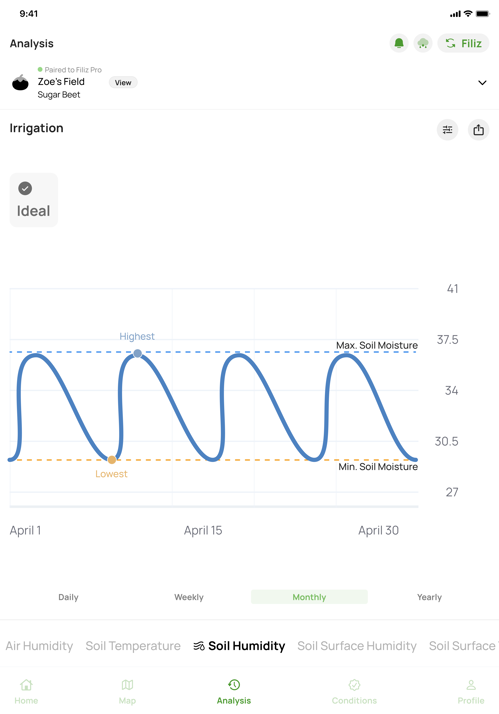
IoTrack’s Analysis feature provides insightful graphs to showcase irrigation activities' efficiency. The graphs mark the minimum and maximum soil moisture levels based on your soil and crop types. These levels are defined as the necessary minimum & maximum soil moisture levels for the healthy continuation of plants' phenological development. Above the maximum soil moisture level signals overirrigation. The minimum soil moisture level is the water stress level, and lower soil moisture leads to plant water stress, which is the most significant barrier to plant development. Additionally, crops that enter water stress experience significant decreases in yield. Staying between these two thresholds is important to optimize plant development and ensure maximum crop and irrigation efficiency. The peaks should touch the thresholds for maximum efficiency.
Case 1: Excessive Irrigation
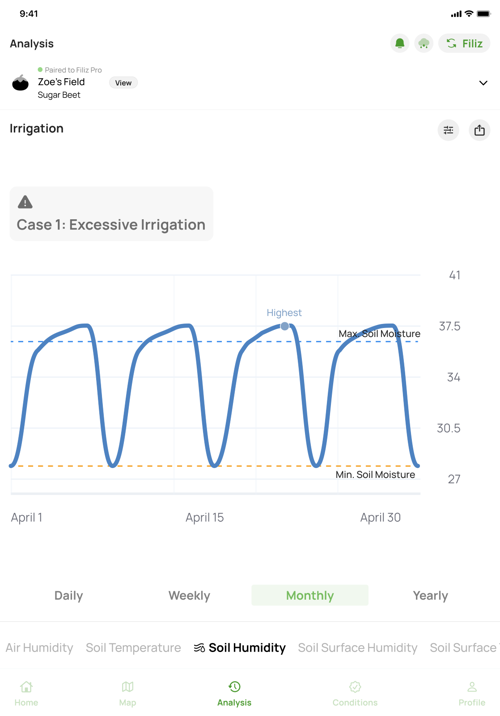
If your IoTrack graph is similar to this or includes a partially similar formation, you are over-irrigating. Over-irrigation is a common mistake, leading to wasted water, increased costs, and potentially harming crop yields. On the graph, peak soil moisture levels frequently exceed the maximum threshold. By pausing irrigation once the moisture exceeds the threshold, you may save water and consume less energy for irrigation.
Excessive irrigation causes air loss in the soil pores, preventing the roots from breathing and preventing the plant from obtaining the necessary nutrients from the soil. In addition, due to moisture in the root area, root and fungal diseases may occur, leading to diseases and an increase in the pest population. These factors lead to a decrease in yield.
Case 2: Excessively Frequent Irrigation

If your IoTrack graph is similar to this or includes a partially similar formation, you are irrigating too frequently. Irrigating too frequently means irrigating when your soil moisture levels are still within a range the plant can use. On the graph, the values increase repeatedly below the maximum soil moisture threshold but do not approach the minimum threshold. It prevents roots from developing properly, leading to unnecessary water use and increasing irrigation costs.
Minor stress is desired in some cases and for various plants, considering the plant’s phenological stages. As a result of this stress, the plant's flower sets, fruit formation, and fruit quality increase. Since the irrigation optimization IoTrack considers plant phenology, frequent irrigation will negatively affect the increases in these characteristics.
Case 3: Stressed Crop

If your IoTrack graph is similar to this or includes a partially similar formation, your crops are water-stressed. When you irrigate insufficiently or less frequently than needed for your soil and crop type, you may observe values below the minimum soil moisture threshold. Under-irrigation can lead to plant water stress, causing a decrease in photosynthetic activity and biochemical and physiological changes, including cell structure damage. This inhibits plant development and can dramatically reduce your crop yield.
Inadequate and infrequent irrigation directly harms the plant's growth rate by slowing photosynthesis. In addition to stressing the plant, it negatively affects flower and fruit set, fruit quality, and product durability.
Case 4: Inadequate Irrigation

If your IoTrack graph is similar to this or includes a partially similar formation, your crops are irrigated inadequately. When the soil moisture levels are above the minimum threshold but fall again before approaching the maximum value, it signals that you are irrigating insufficiently in duration or amount for your soil and crop type. While this case is not as fatal to plant development as always staying above the minimum values, it still leads to effects such as slowed growth and root development problems, preventing farming at maximum efficiency.
Without sufficient irrigation, there is an imbalance between transpiration and water absorption, and plants cannot transport nutrients from the roots to the leaves, negatively affecting plant growth and crop yield.
In conclusion, IoTrack stands as a testament to the power of technology in transforming agriculture. By optimizing irrigation practices, it offers a pathway to more sustainable, efficient, and productive farming. As we embrace the possibilities of precision agriculture, solutions like IoTrack will play a pivotal role in shaping the future of food production.
FAQs
How does IoTrack work?
IoTrack uses Filiz Agricultural Sensor Stations placed in the field to monitor soil moisture levels in real time. This data is then analyzed to provide actionable insights on irrigation practices.
Can IoTrack help reduce water usage?
Yes, by providing precise data on soil moisture levels and weather forecasts, IoTrack enables farmers to use water more efficiently, reducing overall consumption.
How does IoTrack contribute to sustainable agriculture?
By optimizing water and energy use, IoTrack supports more sustainable farming practices that conserve resources and protect the environment.
Can IoTrack improve crop yields?
Yes, by ensuring crops receive the optimal amount of water, IoTrack helps improve plant health and can lead to higher yields.
How easy is it to implement IoTrack in my farming operations?
Implementing IoTrack is straightforward. The main requirement is the installation of Filiz in your field. The application provides clear and actionable insights for efficient water management. You can simply pair your Filiz with your IoTrack app by scanning the QR code on Filiz.
For those interested in exploring how Doktar's innovative solutions can transform your agricultural practices, visit our website for detailed information on all our products. Stay updated with the latest developments by following us on Instagram and LinkedIn, where we share insights, tips, and updates about our technologies and their impact on modern farming.

Agriculture Technology and Data-Driven Harvests: The New Frontier in Innovation
Agriculture technology, or agritech, is revolutionizing farming by integrating advanced tools like AI, drones, IoT, and precision agriculture. Companies like Doktar are leading this shift, enabling farmers to optimize operations, improve yields, and enhance sustainability. Through data-driven solutions, farmers can reduce resource use, boost productivity, and secure sustainable harvests.
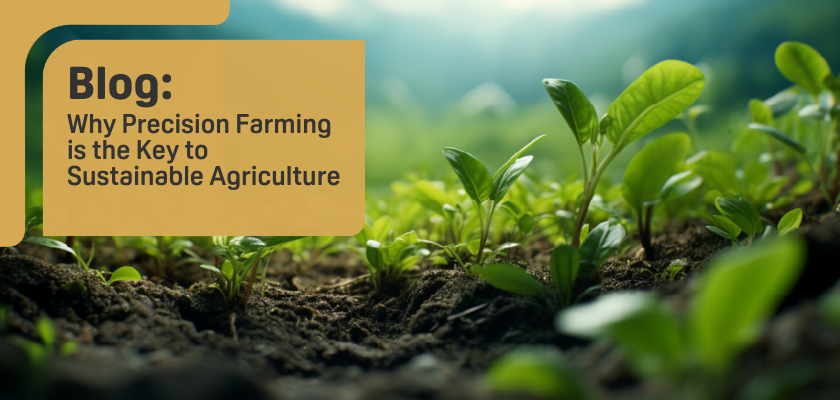
Why Precision Farming is the Key to Sustainable Agriculture
Precision farming is a modern agricultural approach using data-driven technologies like sensors, AI, and satellite imagery to optimize crop management. It enhances resource efficiency, reduces waste, and increases productivity by enabling tailored care for different field zones. This promotes sustainability by lowering environmental impacts, improving yields, and cutting operational costs.
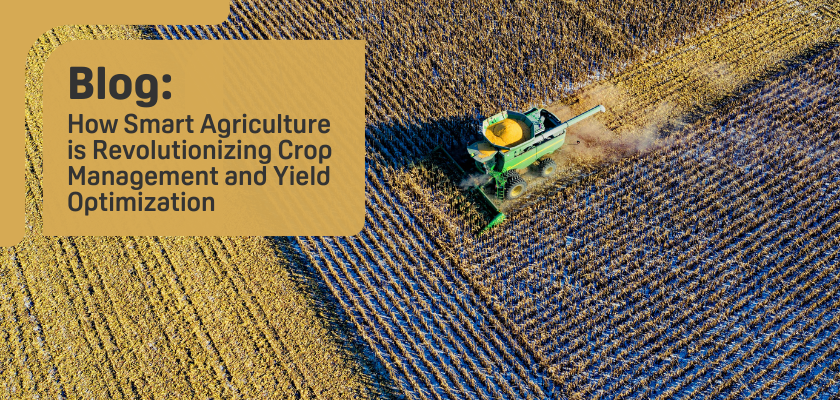
How Smart Agriculture is Revolutionizing Crop Management and Yield Optimization
Smart agriculture integrates technologies like IoT, AI, and big data to optimize crop management, increase yields, reduce resource waste, and enhance sustainability. Tools like Doktar’s Filiz and PestTrap provide real-time data, enabling farmers to make informed decisions, mitigate risks, and adopt more efficient, eco-friendly practices in modern farming.
